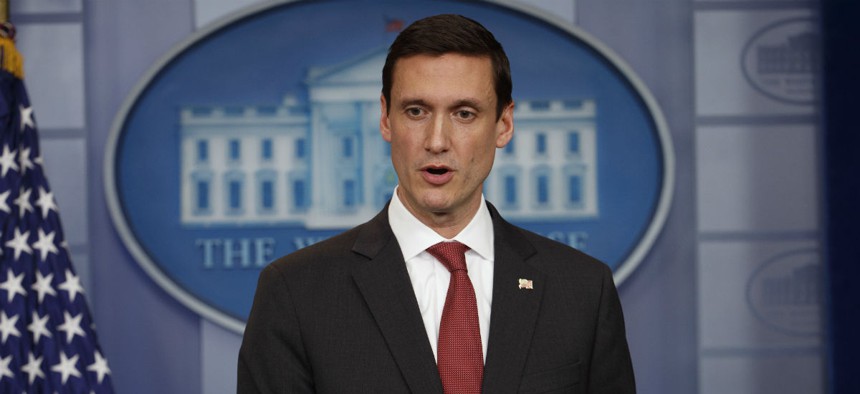Trump Releases Long-Delayed Cyber Order

Homeland Security Adviser Tom Bossert speaks during the daily White House press briefing May 11. Evan Bucci/AP
The order was delayed so security and modernization programs can work in tandem, an official said.
Editor's note: This article was updated with comments from former White House official Michael Daniel.
President Donald Trump signed a long-delayed cybersecurity executive order today that mandates federal agencies follow cybersecurity best practices and that top agency leaders be held accountable for breaches.
The order is broadly similar to a draft circulated to industry and cyber experts several weeks ago.
It was delayed, in part, to ensure efforts to modernize government technology are done in tandem with cybersecurity efforts, White House Homeland Security Adviser Tom Bossert said during a White House daily press briefing.
» Get the best federal technology news and ideas delivered right to your inbox. Sign up here.
Trump specifically wanted to announce the formation of the American Technology Council, which he’ll head personally and that will focus on modernizing government information technology, before the cybersecurity order was released, Bossert said.
The order was also postponed until the president could release his budget wish list for the fiscal year, Bossert said.
That budget includes funding hikes for cybersecurity components at the Justice Department and FBI and for the Homeland Security Department, which is the government’s lead civilian cyber agency.
The White House budget is only advisory and will likely be changed significantly as it works its way through Congress.
The White House announced Trump would sign a cybersecurity executive order during his first weeks in office, but that signing was abruptly canceled.
“We’ve sometimes been criticized for doing things too quickly and now we may be criticized for doing things too slowly,” Bossert said, adding “maybe I’m right in the middle of the sweet spot.”
Industry’s initial reaction to the order was muted with several companies and associations saying they looked forward to reviewing it.
One key consideration for the order’s effectiveness will be the extent to which Trump follows through on his promise to hold agency heads accountable for security lapses, John Bambenek, threat intelligence manager for the cybersecurity firm Fidelis, told Nextgov.
“If you’re not going to face any real consequences, why would I spend time and money on this?” Bambenek said. “If the answer is the president can fire me while I’m addressing my employees and they see the news of me being fired on the TV behind me, that’s kind of a motivator.”
In large companies, “although the CEO is not a cybersecurity expert, he or she is ultimately responsible for implementing a cybersecurity plan that mitigates risk to the business,” McAfee Chief Technology Officer Steve Grobman said.
Another key will be whether the president fills top cybersecurity management posts at the White House, DHS and other agencies that will be responsible for assuring implementation of many elements of the order, said Betsy Cooper, executive director of the Center for Long-Term Cybersecurity at the University of California, Berkeley.
The order urges government agencies to share more IT infrastructure, such as financial and human resources systems, which can save money as well as make cyber protections easier to implement. Shared services will be a major component of government IT modernization, White House Cybersecurity Coordinator Rob Joyce has said.
The order also requires a series of reports to the White House on topics including cyber protections for critical infrastructure, such as dams and energy plants, gaps in cyber protections for the electrical grid and marketplace transparency in the cybersecurity industry.
Another report will focus on the “scope and sufficiency of efforts to educate and train the American cybersecurity workforce of the future, including cybersecurity-related education curricula, training and apprenticeship programs, from primary through higher education.”
Former White House Cybersecurity Coordinator Michael Daniel described the order as largely in line with Obama administration cyber policy and as “more of a plan for a plan,” though the reports it requires are “good ones to have.”
“In general, I don't see anything unusual or that really goes in a different policy direction,” Daniel said.
NEXT STORY: The Voting Technology We Really Need? Paper






